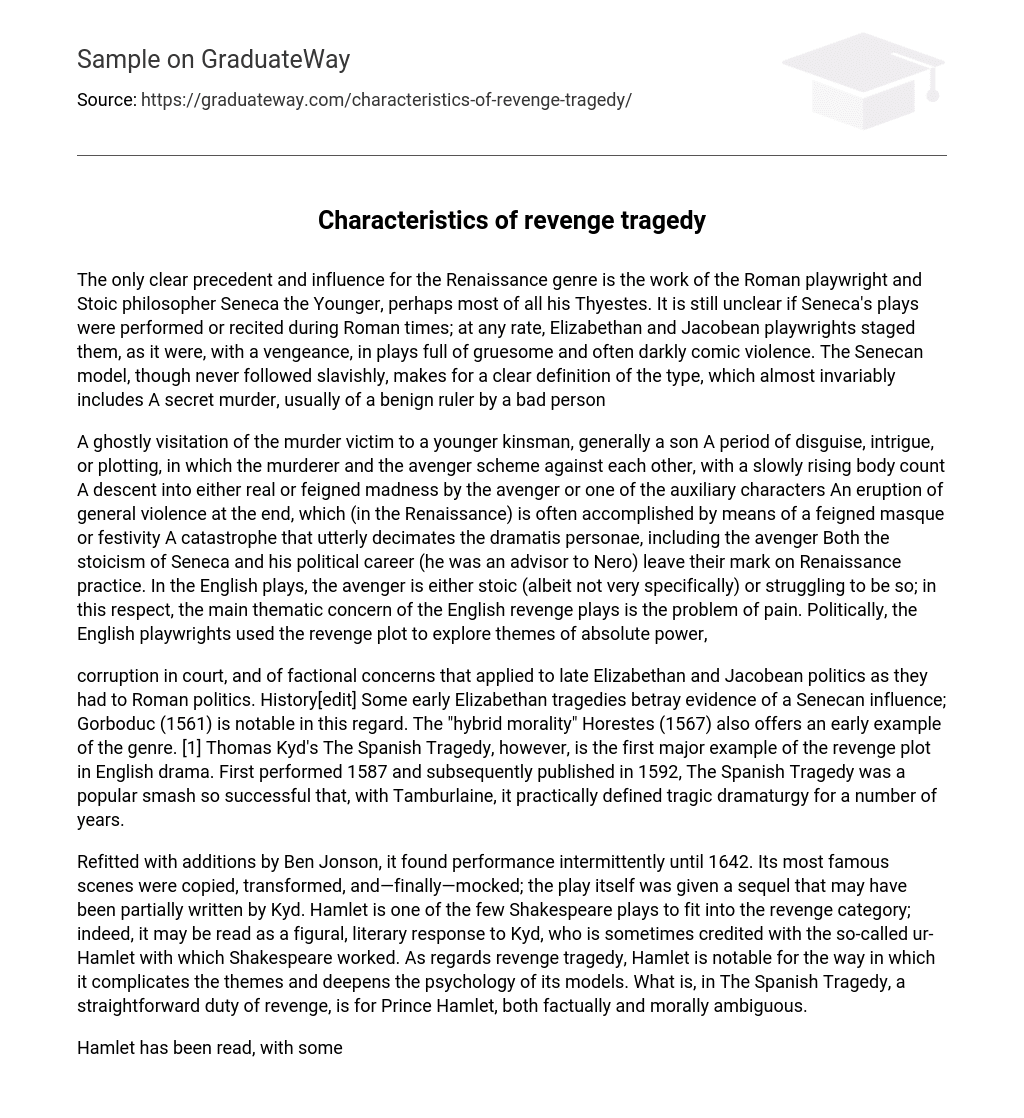The Renaissance genre draws clear inspiration from the works of Seneca the Younger, a Roman playwright and Stoic philosopher, particularly his play Thyestes. It remains uncertain whether Seneca’s plays were performed or recited in ancient Rome. Nevertheless, Elizabethan and Jacobean playwrights incorporated them into their own works with intense violence that often had a darkly comedic element. While not strictly adhered to, the Senecan model provides a distinct definition of the genre, often featuring a clandestine assassination of a benevolent leader by a malevolent individual.
A ghostly visitation from the murder victim to a younger kinsman, typically a son, sets off a period of disguise, intrigue, and plotting. The murderer and the avenger scheme against each other, resulting in a growing body count. The avenger or one of the auxiliary characters descends into madness, either real or feigned. The story culminates in a violent ending, often achieved through a feigned masque or festivity in the Renaissance. The catastrophe ultimately devastates all the characters, including the avenger. Seneca’s stoicism and his role as Nero’s advisor heavily influence Renaissance practice. In English revenge plays, the avenger is either stoic or struggling to be one, reflecting the main thematic concern of the problem of pain. Additionally, politically, English playwrights use the revenge plot to explore themes of absolute power.
Corruption in court and factional concerns were prevalent in late Elizabethan and Jacobean politics, just as they were in Roman politics. In terms of history, some early Elizabethan tragedies showed signs of being influenced by Seneca. Notable among these is Gorboduc (1561). The genre can be seen early on in the “hybrid morality” of Horestes (1567). [1] However, Thomas Kyd’s The Spanish Tragedy stands as the first prominent example of a revenge plot in English drama. It was first performed in 1587 and later published in 1592. The Spanish Tragedy was a highly successful play that, along with Tamburlaine, had a significant impact on tragic dramaturgy for many years.
Ben Jonson made additions to the play and it was performed sporadically until 1642. The play’s famous scenes were copied, changed, and eventually ridiculed. A sequel to the play was created, possibly with contributions from Kyd. Hamlet is one of the few plays by Shakespeare that falls into the revenge genre. It can be seen as a literary response to Kyd’s ur-Hamlet, which Shakespeare may have worked on. In terms of revenge tragedy, Hamlet stands out for its complex themes and deep psychological exploration. What is a clear duty of revenge in The Spanish Tragedy becomes morally and factually ambiguous for Prince Hamlet.
The thematic conflict in Hamlet can be interpreted as a clash between Roman values, such as martial valor and blood-right, and Christian values of humility and acceptance. Some scholars also see revenge as a prominent theme in Othello. The Revenger’s Tragedy, which was most likely written in 1606 and anonymously published the following year, is considered a more representative example of Jacobean literature than Hamlet. For a long time, it was believed that Cyril Tourneur was the author based on weak external evidence, but in recent years, many critics have made a convincing argument attributing the play to Thomas Middleton based on stylistic analysis.
The Revenger’s Tragedy is characterized by its earthy, even obscene, style, irreverent tone, and grotesque subject matter that is typical of Middleton’s comedies. While the play lacks a ghost, it is nonetheless a sophisticated modernization of The Spanish Tragedy, which explores lust, greed, and corruption within an Italian court. Caroline works in this genre are largely derived from earlier models and are not widely read today, even by experts in the field. Influence: Several plays from 1587 onwards are influenced by certain aspects of revenge tragedy, although they do not completely fit into this category. In addition to Hamlet, other plays by Shakespeare such as Titus Andronicus, Julius Caesar, and Macbeth also contain some elements of revenge.
Other revenge tragedies that can be mentioned include The White Devil, Hoffman, The Changeling, The Duchess of Malfi, The Atheist’s Tragedy, The Revenger’s Tragedy, The Jew of Malta, The Revenge of Bussy D’Ambois, The Malcontent, Antonio’s Revenge, The Duke of Milan, The Maid’s Tragedy, Valentinian, The Bloody Brother, ‘Tis Pity She’s a Whore”, The Maid’s Revenge, and The Cardinal. Thomas Pynchon’s novel The Crying of Lot 49 features an extended parody of the Jacobean revenge-play formula known as The Courier’s Tragedy. This play is written by the fictional Richard Wharfinger and its events are mostly described by the narrator, occasionally with snippets of dialogue. In Edward Gorey’s renowned work, The Unstrung Harp, the protagonist Mr Earbrass attends a performance of Prawne’s fictional revenge play The Nephew’s Tragedy. This play is performed by the West Mortshire Impassioned Amateurs of Melpomene and marks its first performance since the early seventeenth century.





